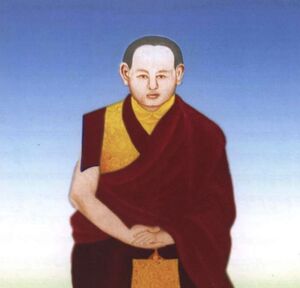The Great Other-Emptiness[edit]
The Zhentong Chenmo, or Fearless Lion's Roar: The Tradition of Jonang Which Ascertains the Profound Meaning of the Supreme Vehicle of Cause and Result (རྒྱུ་དང་འབྲས་བུའི་ཐེག་པ་མཆོག་གི་གནས་ལུགས་ཟབ་མོའི་དོན་རྣམ་པར་ངེས་པ་རྗེ་ཇོ་ནང་པ་ཆེན་པོའི་རིང་ལུགས་འཇིགས་མེད་གདོང་ལྔའི་ང་རོ།), is perhaps the last great work to be written on buddha-nature, particularly highlighting its interpretation in association with the philosophy of zhentong, or other-emptiness. Commonly known as the Zhentong Chenmo, or Great Other-Emptiness, this treatise is a work of Ngawang Lodrö Drakpa (1720-75), a luminary of the Zamthang monastery in Amdo. Ngawang Lodrö Drakpa, also known as Mati Rinpoche, was a leading scholar of Jonang centers in Zamthang in the twentieth century and was considered an incarnation of great Jonang hierarchs such as Dolpopa and Tāranātha, although he himself mentions the 8th Tsechu Ratnakīrti, who requested him to compose this work, as the incarnation of Dolpopa.
Ngawang Lodrö Drakpa studied with leading Jonangpa figures of his time and composed many works which today fill ten volumes of his collected writings. Most of his works were transcribed by his disciple Ngawang Yonten Zangpo, who not only served as the scribe for this work but also made offerings to Ngawang Lodrö Drakpa requesting him to compose it. He started the composition of this work on the 10th day of the 5th Tibetan month, 1965 and completed it in the 7th month of the same year in Zamthang, months before the horrific destruction of the Cultural Revolution started to take place across China.
Composed at the cusp of tragic cultural and religious persecution in Tibet, the Zhentong Chenmo is the most outstanding philosophical work by Ngawang Lodrö Drakpa, presenting his detailed explanation and arguments for zhentong philosophy espoused by the Jonang school. Alongside Dolpopa's Mountain Doctrine and Tāranātha's Thoroughly Ascertaining the Great Middle Way of the Expansive Supreme Vehicle, the treatise today ranks among the most authoritative writings on zhentong philosophy of the Jonang school. The work starts with the discussion of the three wheels and delves into the topic of the ground reality, or zhi, by discussing it through ten different modes. He points out how Ngok Lotsāwa understood buddha-nature as emptiness which is a nonimplicative negation, Sakya Paṇḍita took buddha-nature to be an emptiness free from elaborations, Butön equated it with store-consciousness, and Dolpopa, whose tradition he follows, defines buddha-nature as the innate pristine awareness which has all qualities of the Buddha latent in it. Michael Sheehy's "The Gzhan stong Chen mo: A Study of Emptiness according to the Modern Tibetan Buddhist Jo Nang Scholar 'Dzam Thang Mkhan Po Ngag Dbang Blo Gros Grags Pa (1920–75)", comprehensively renders this section of the book while also providing clear and insightful contextual information on this work, its author, and the tradition.
The work is generally laid out, as shown in the author's own outline, into the ground, path, and fruition for both the exoteric sūtra system and the esoteric tantric system. In order to substantiate his claims in both systems, the author provides scriptural citations and references as well as rational arguments in support of his philosophical position. The philosophical presentation is interspersed with poetic composition at the conclusion of the chapters. While the work clearly promotes the philosophical position of the Jonang tradition, Ngawang Lodrö Drakpa also adopts a very respectful and ecumenical approach and acknowledges in the colophon that the ultimate intent of the different traditions in India, which were received from Nāgārjuna and Asaṅga, and the different traditions in Tibet, including the Kagyu, Sakya, Nyingma and Geluk received through their respective founding fathers, all converge in the ultimate understanding of the Great Definitive Middle Way (ངེས་དོན་དབུ་མ་ཆེན་པོ་). Thus, all teachings are seen as noncontradictory and all texts as instructions leading to the realization of the ultimate buddha-nature.
The book is available online in two versions. Digital copies of the old pecha published from xylographic blocks made in 1999 in Zamthang Samdrup Norbuling monastery are available through the Tibetan Buddhist Resource Center (W19762), and copies of the more recent edition in book format published by the Tibetan Buddhist College of Yonghegong Temple in Beijing are also available. The latter is an incomplete and almost verbatim reproduction of the former but attributed to Ngawang Lodrö Drakpa's disciple and scribe Ngawang Yonten Zangpo. It also does not contain texts from f.4 to f.32 in the former version and differs significantly toward the end of the book. Thus, the book published in Beijing must have relied on an exemplar which is incomplete, while the former contains the complete text with a long colophon and information on the publication and also artistic renderings of deities at the beginning and end.
Weekly quote[edit]
~

